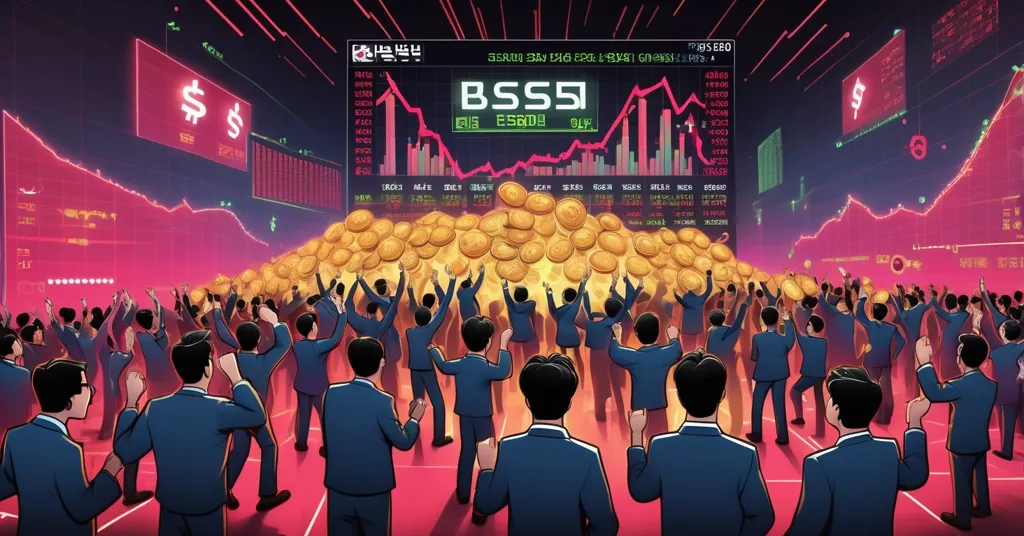South Korea’s KOSPI Soars 30% on Won-Backed Stablecoin Pledge: Boom or Bust?

Korean Stocks Surge on President Lee’s Won-Backed Crypto Pledge: Brilliance or Bubble?
South Korea’s financial markets are on fire in the first half of 2025, with the KOSPI index skyrocketing nearly 30% year-to-date, fueled by President Lee Jae-myung’s audacious commitment to support stablecoins pegged to the Korean won. Crypto-linked stocks like Kakao Pay have doubled in value, retail investors are borrowing billions, and the promise of spot crypto ETFs looms large—but beneath the hype, serious risks and regulatory uncertainties threaten to derail this digital gold rush.
- Market Explosion: KOSPI up 30% YTD, driven by crypto enthusiasm under President Lee’s policies.
- Stock Winners: Kakao Pay doubles, LG CNS surges 70%, and ME2ON triples on stablecoin bets.
- Policy Shift: Won-backed stablecoins and spot crypto ETFs signal a pro-crypto agenda.
- Hidden Dangers: Speculative mania, undercapitalized issuers, and central bank pushback loom large.
A Crypto-Fueled Market Mania Grips South Korea
Picture this: a nation so obsessed with digital assets that trading floors and chat rooms buzz louder than a K-pop concert. South Korea, already a heavyweight in the global crypto arena, is witnessing a historic rally in 2025. The KOSPI, the country’s premier stock index, has soared to near four-year highs, logging a 30% gain year-to-date and outpacing every other Asian market. This isn’t driven by traditional tech giants or industrial powerhouses—it’s the allure of blockchain and cryptocurrency, supercharged by President Lee Jae-myung’s election promise to integrate digital assets into the financial mainstream. His flagship policy? Supporting stablecoins pegged to the Korean won, a move that’s sent investors into a frenzy.
For the uninitiated, stablecoins are cryptocurrencies designed to avoid the rollercoaster swings of Bitcoin or Ethereum by tying their value to a stable asset, like a fiat currency. A won-backed stablecoin, in theory, acts like a digital version of South Korea’s currency, promising price stability with the speed and efficiency of blockchain tech. Think of it as cash you can send instantly across borders without bank fees or delays—a game-changer for payments and trade if done right. And South Koreans, who’ve long embraced crypto with open arms (trading volumes for dollar-pegged stablecoins hit a staggering Won 57 trillion, or $42 billion, in Q1 2025), are betting big that this is the future.
Crypto Stocks Steal the Spotlight: Who’s Winning Big?
The market surge has minted overnight winners among companies with any whiff of blockchain involvement. Kakao Pay, a leading fintech platform, has seen its stock value double in a single month, fueled by speculation it could play a central role in stablecoin transactions or infrastructure. LG CNS, an IT services firm tied to the Bank of Korea’s digital currency experiments, rocketed nearly 70% before a minor pullback, reflecting investor confidence in its blockchain expertise. Over on the Kosdaq, the junior market for smaller players, the gains are even more absurd. Aton, a fintech security firm, spiked 80%, while ME2ON, a mobile game developer, tripled its value after a subsidiary launched a dollar-pegged stablecoin for online casino platforms. These aren’t just random jumps—these companies are riding a wave of optimism that crypto, and specifically stablecoins, will redefine South Korea’s economy, as seen in recent analyses of crypto stock surges like Kakao Pay.
But let’s not get starry-eyed just yet. Are these valuations based on real innovation or pure hype? Kakao Pay’s expertise in digital payments positions it well for stablecoin integration, sure, but ME2ON’s casino stablecoin feels more like a gimmick than a revolution. Without concrete partnerships or tech breakthroughs, some of these gains smell suspiciously like speculative bubbles. South Korea’s history with crypto mania—think the 2017 ICO craze or the Terra-LUNA crash of 2022—serves as a harsh reminder that hype can vanish faster than a rug-pull scam.
Retail Investors: All In, But at What Cost?
At the heart of this rally are South Korea’s retail investors, a passionate bunch who’ve turned crypto trading into a national pastime. They’re not just dipping their toes—they’re diving headfirst, borrowing heavily to amplify their bets. Margin loans, essentially borrowed cash to buy more stocks, have ballooned to Won 20.5 trillion ($15 billion), according to the Korea Financial Investment Association. Picture a young trader in Seoul maxing out loans to snap up Kakao Pay shares, dreaming of quick riches. Sound familiar? It’s the same fervor that fueled past bubbles, and the parallels to disasters like Terra-LUNA, where billions evaporated overnight, are chilling, as discussed in community forums like Reddit threads on South Korea’s crypto market surge.
This speculative madness is a double-edged sword. On one hand, retail enthusiasm drives adoption and pumps liquidity into the market, proving there’s genuine public demand for crypto innovation. On the other, leveraging up to the hilt means a market downturn could wipe out savings and trigger cascading defaults. South Korea’s youth, often squeezed by high unemployment and societal pressure for fast wealth, see crypto as a ticket out. But if this rally pops, the fallout won’t just be financial—it’ll be cultural, denting trust in digital assets for years. Is South Korea speeding toward a new financial frontier, or a cliff?
Policy Push: Won-Backed Stablecoins and ETFs Take Center Stage
President Lee Jae-myung’s administration, with digital asset advocate Kim Yong-beom as chief policy adviser, is rolling the dice on a crypto-friendly future. A proposed bill from the ruling party would allow companies with as little as Won 500 million ($370,000) in equity to issue won-backed stablecoins. Let that sink in—a firm with less capital than a modest Seoul apartment could back a currency meant to anchor digital transactions. Meanwhile, the Financial Services Commission (FSC) is crafting a roadmap to approve spot crypto ETFs—funds that track actual cryptocurrency prices—in the second half of 2025, reversing years of bans over volatility fears. These moves are bold, catering to a tech-savvy electorate hungry for innovation, but they’re also a regulatory minefield, with significant concerns over President Lee’s crypto policy impacts.
Let’s break down the stablecoin mechanics for a second. To maintain a peg to the won, issuers must hold reserves—real cash or assets—to back every token, ensuring users can redeem them 1:1. Some use algorithms to adjust supply, but the core issue here is trust. If a company with pocket change for reserves issues billions in tokens and can’t cover withdrawals during a panic, it’s game over. Think of Tether’s past controversies, where doubts over reserve transparency spooked markets. Now imagine that on a national scale with undercapitalized South Korean firms. Critics warn this low barrier could flood the system with shaky tokens, risking a systemic meltdown if faith falters. Letting toddlers drive Ferraris comes to mind—disaster is just one bad turn away, as explored in discussions on risks associated with won-backed stablecoins.
Bank of Korea’s Pushback: A Cautious Counterweight
Enter the Bank of Korea, playing the role of the skeptical parent at a teenage crypto rave. Governor Rhee Chang-yong has been vocal about the dangers of non-bank entities issuing stablecoins, warning they could mess with capital flows and undermine monetary policy. If private digital won tokens flood the market, how does the central bank manage the economy—control price rises or tweak interest rates—when an unregulated currency competes with its own? Senior Deputy Governor Ryoo Sang-dai has floated a phased approach, suggesting only tightly regulated banks should issue stablecoins initially, before even considering smaller players. It’s a sensible middle ground, but one that might throttle the breakneck innovation Lee’s team is pushing, as detailed in recent updates on the Bank of Korea’s stance and CBDC pilots.
To counter private stablecoins, the Bank is accelerating its own central bank digital currency (CBDC), a state-backed digital won. After a 2023 pilot with the Bank for International Settlements, a second test with major commercial banks is in the works. This isn’t just a tech upgrade—it’s a power play. A government-controlled digital currency could outmuscle private tokens, ensuring the central bank keeps its grip on the money supply. But here’s the rub: does a CBDC align with the decentralized spirit of crypto, or is it just surveillance-friendly fiat in blockchain clothing? For Bitcoin purists like myself, it’s hard to cheer for anything that smells of centralized overreach, even if it’s pitched as stability.
South Korea’s Crypto Gamble: A Global Test Case
Zoom out, and South Korea’s moves carry weight far beyond its borders. If President Lee’s policies succeed, they could inspire nations like Japan or Singapore to greenlight national currency-pegged stablecoins or relax crypto ETF rules. A functioning won-backed stablecoin system might streamline cross-border payments and prove blockchain’s worth in everyday finance, setting a blueprint for global adoption. But if it flops—say, an undercapitalized issuer collapses and sparks a crisis—regulators worldwide will point and scoff, “Told you so.” This isn’t just a local experiment; it’s a litmus test for balancing innovation with stability in the blockchain era, with market performance reflecting this dynamic as seen in KOSPI’s 2025 data and policy impact analysis.
Adding another layer, the tension between private stablecoins and the Bank of Korea’s CBDC raises bigger questions. Will a state-backed digital won crush smaller players, or can they coexist with clear rules? And where does this leave Bitcoin and the ethos of decentralization we hold dear? Stablecoins might bridge crypto to traditional finance with their pegged stability, but they often trade freedom for oversight—a compromise that grates against Bitcoin’s rebellious core. I’ll grudgingly admit they fill a niche for the risk-averse, but don’t expect me to wave pom-poms for anything diluting crypto’s rogue spirit.
Red Flags: Echoes of Past Crypto Catastrophes
Let’s cut the bullshit—South Korea’s crypto history is a cautionary tale. The 2017-2018 ICO bubble saw naive investors dump savings into sketchy token sales, only to get burned when regulators slammed the brakes. The Terra-LUNA implosion of 2022, cooked up by South Korean developers, obliterated billions and left retail traders reeling. Now, with margin loans at nosebleed levels and half-baked stablecoin policies on the table, the ghosts of those disasters loom large. Won-backed stablecoins could be transformative, sure, but if the backing is flimsy, we’re staring at a house of cards. And don’t even get me started on the so-called “experts” screaming ‘KOSPI to the moon’—baseless price predictions are just noise, not insight. Focus on the fundamentals, not shill-driven fantasies, especially when considering the basics of stablecoin structures in South Korea.
On the flip side, there’s an argument that private stablecoins could light a fire under stodgy institutions, forcing central banks to innovate faster. Competition isn’t always chaos; sometimes it’s the kick needed to drag finance into the 21st century. But without ironclad safeguards, this feels like wishful thinking. South Korea’s past proves that unchecked hype plus retail fervor equals a recipe for pain. The line between disruption and disaster is razor-thin.
Bitcoin’s Shadow: Decentralization at Risk?
As a Bitcoin maximalist, I can’t help but squint at the stablecoin circus. Bitcoin’s power lies in its defiance—no pegs, no masters, just hard, unassailable money. Stablecoins and CBDCs, with their centralized strings, risk sidelining the very principles of freedom and privacy that sparked this revolution. Yet, I’ll concede a point: Bitcoin’s volatility makes it a tough sell for daily transactions, and stablecoins can fill that gap, acting as on-ramps for the masses. South Korea’s DeFi scene, often built on Ethereum and other protocols, also shows altcoins carving out niches Bitcoin doesn’t touch. If Lee’s policies can protect decentralization while harnessing stablecoin utility, I’m listening—but right now, the specter of overregulation and state control looms too damn large.
What’s Next for South Korea’s Crypto Experiment?
The road ahead is murky. Spot crypto ETF approvals could hit by late 2025, per the FSC’s roadmap, potentially unleashing another wave of investment. The Bank of Korea’s CBDC pilots might roll out broader trials soon, setting up a showdown with private tokens. Meanwhile, retail investors keep piling into debt-fueled bets, and undercapitalized stablecoin issuers wait in the wings. South Korea is at a pivotal moment—Lee’s vision aligns with the disruptive, accelerationist ethos we champion, pushing blockchain into the mainstream. But without serious guardrails, this could implode, setting adoption back a decade. Innovation is worthless if it’s reckless. So, are won-backed stablecoins a golden ticket, or a ticking time bomb? Weigh the evidence yourself.
Key Questions and Takeaways on South Korea’s Crypto Surge
- What’s driving South Korea’s 2025 crypto stock boom?
A 30% KOSPI surge year-to-date is powered by President Lee Jae-myung’s pledge for won-backed stablecoins, lifting crypto stocks like Kakao Pay, which doubled in value. - Which South Korean companies are leading this crypto rally?
Kakao Pay soared 100%, LG CNS jumped 70%, Aton gained 80%, and ME2ON tripled after launching a casino stablecoin, riding blockchain optimism. - Why are won-backed stablecoins a risky bet for South Korea?
Proposed rules let firms with just $370,000 in equity issue tokens, risking a flood of underbacked currencies that could collapse under redemption pressure. - How are retail investors fueling this crypto mania?
Borrowing has hit $15 billion in margin loans, echoing dangerous past bubbles like Terra-LUNA, signaling a potential crash if hype fades. - What’s the Bank of Korea’s stance on private stablecoin plans?
Wary of economic disruption, it’s speeding up a digital won CBDC while pushing for bank-only issuance initially, countering non-bank risks. - Can South Korea’s crypto policies shape global blockchain trends?
Success might spur nations like Japan to adopt similar stablecoin or ETF frameworks; failure could reinforce worldwide doubts on unregulated assets. - Where does Bitcoin fit in South Korea’s stablecoin-focused future?
Stablecoins offer stability for daily use, but Bitcoin’s decentralized ethos risks being eclipsed by centralized tokens and CBDCs unless freedoms are safeguarded.



